Direction : Carefully read the following information to answer Q.no.1 and Q.no.2
An egg farmer is experimetnting with different feed rations with the aim of increasing his production whilst reducing the cost of the feed per egg produced. The data from two feeding experiments is given below.

Which feed composition give the least cost per egg produced ?
Protein (concentration (%)Total vitamin level(mg/kg)16100
Protein (concentration (%)Total vitamin level(mg/kg)1450
Protein (concentration (%)Total vitamin level(mg/kg)14100
Protein (concentration (%)Total vitamin level(mg/kg)14150
The correct Answer is:D
In experiment 1, cost per egg produced from different protein concentrations can be calculated as follows:
Cost per egg =Cost of feed per 100 hens per dayNumber of eggs per 100 hens per day
The calculations show that the cost per egg for different protein concentrations is 0.085,0.100,0.100,0.100,0.109 and 0.112 respectively.
Similarly in experiment 2, cost per egg is found to be 0.114,0.103,0.100,0.097,0.094,0.097 and 0.100 respectively with increased vitamin level. Hence, on analysing the given experimental results, it becomes clear that least cost per egg in incurred in feed with 10% protein concentration and vitamin level at 100mg/kg but out of the given options, option (d) i.e., feed ration with 14% protein concentration and 150mg/kg vitamin level gives the least cost per egg i.e., 0.094.
Topper's Solved these Questions
- STRATEGIES FOR ENHANCEMENT IN FOOD PRODUCTIONBOOK - NCERT FINGERTPS ENGLISHCHAPTER - STRATEGIES FOR ENHANCEMENT IN FOOD PRODUCTIONEXERCISE - NCERT (EXEMPLAR PROBLEMS)
25 Videos
- STRATEGIES FOR ENHANCEMENT IN FOOD PRODUCTIONBOOK - NCERT FINGERTPS ENGLISHCHAPTER - STRATEGIES FOR ENHANCEMENT IN FOOD PRODUCTIONEXERCISE - ASSERTION & REASON
15 Videos
- STRATEGIES FOR ENHANCEMENT IN FOOD PRODUCTIONBOOK - NCERT FINGERTPS ENGLISHCHAPTER - STRATEGIES FOR ENHANCEMENT IN FOOD PRODUCTIONEXERCISE - Strategies For Enhancement In Food Production
151 Videos
- SEXUAL REPRODUCTION IN FLOWERING PLANTSBOOK - NCERT FINGERTPS ENGLISHCHAPTER - SEXUAL REPRODUCTION IN FLOWERING PLANTSEXERCISE - Sexual Reproduction In Flowering Plants
145 Videos
Similar Questions
The Betatron was the first important machine for producing high energy electrons. The action of the betatron depends on the same fundamental principle as that of the transformer in which an alternating current applied to a primary coil induces an altermating current usually with higher or lower voltage in the secondary coil. In the betatron secondary coil is replaced by a doughnut shaped vacuum chamber.Electron produced in the doughnut from a hot filament, are given a preliminary acceleration by the application of an electric field having potential difference of 20kV to 70kV, when an alternating magnetic field is applied parallel to the axis of the tube, two effects are produced (1) an electromotive force is produced in the electron orbit by the changing magnetic flux that gives an additional energy to the electrons (2) a radial force is produced by the action of magnetic field whose direction is perpendicular to the electron velocity. Which keeps the electron moving in a circular path. Conditions are arranged such that the increasing magnetic field keeps the electron in a circular orbit of constant radius. The mathematical relation between the betatron parameters to ensure the above condition is called BETATRON condition.
If the orbit radius of the circular path traced by the electron is R, magnetic field is B, speed of the electron is v, mass of the electron is m, charge on the electron is e and ϕ is the flux within the orbit of radius R. Then answer the following questions based on the above comprehension.
What is the tangential force acting on the electron ?
View SolutionThe Betatron was the first important machine for producing high energy electrons. The action of the betatron depends on the same fundamental principle as that of the transformer in which an alternating current applied to a primary coil induces an altermating current usually with higher or lower voltage in the secondary coil. In the betatron secondary coil is replaced by a doughnut shaped vacuum chamber.Electron produced in the doughnut from a hot filament, are given a preliminary acceleration by the application of an electric field having potential difference of 20kV to 70kV, when an alternating magnetic field is applied parallel to the axis of the tube, two effects are produced (1) an electromotive force is produced in the electron orbit by the changing magnetic flux that gives an additional energy to the electrons (2) a radial force is produced by the action of magnetic field whose direction is perpendicular to the electron velocity. Which keeps the electron moving in a circular path. Conditions are arranged such that the increasing magnetic field keeps the electron in a circular orbit of constant radius. The mathematical relation between the betatron parameters to ensure the above condition is called BETATRON condition.
If the orbit radius of the circular path traced by the electron is R, magnetic field is B, speed of the electron is v, mass of the electron is m, charge on the electron is e and ϕ is the flux within the orbit of radius R. Then answer the following questions based on the above comprehension.
What is the BETATRON condition ?
View Solution
Knowledge Check
Direction : Carefully read the following information to answer Q.no.1 and Q.no.2
An egg farmer is experimetnting with different feed rations with the aim of increasing his production whilst reducing the cost of the feed per egg produced. The data from two feeding experiments is given below.
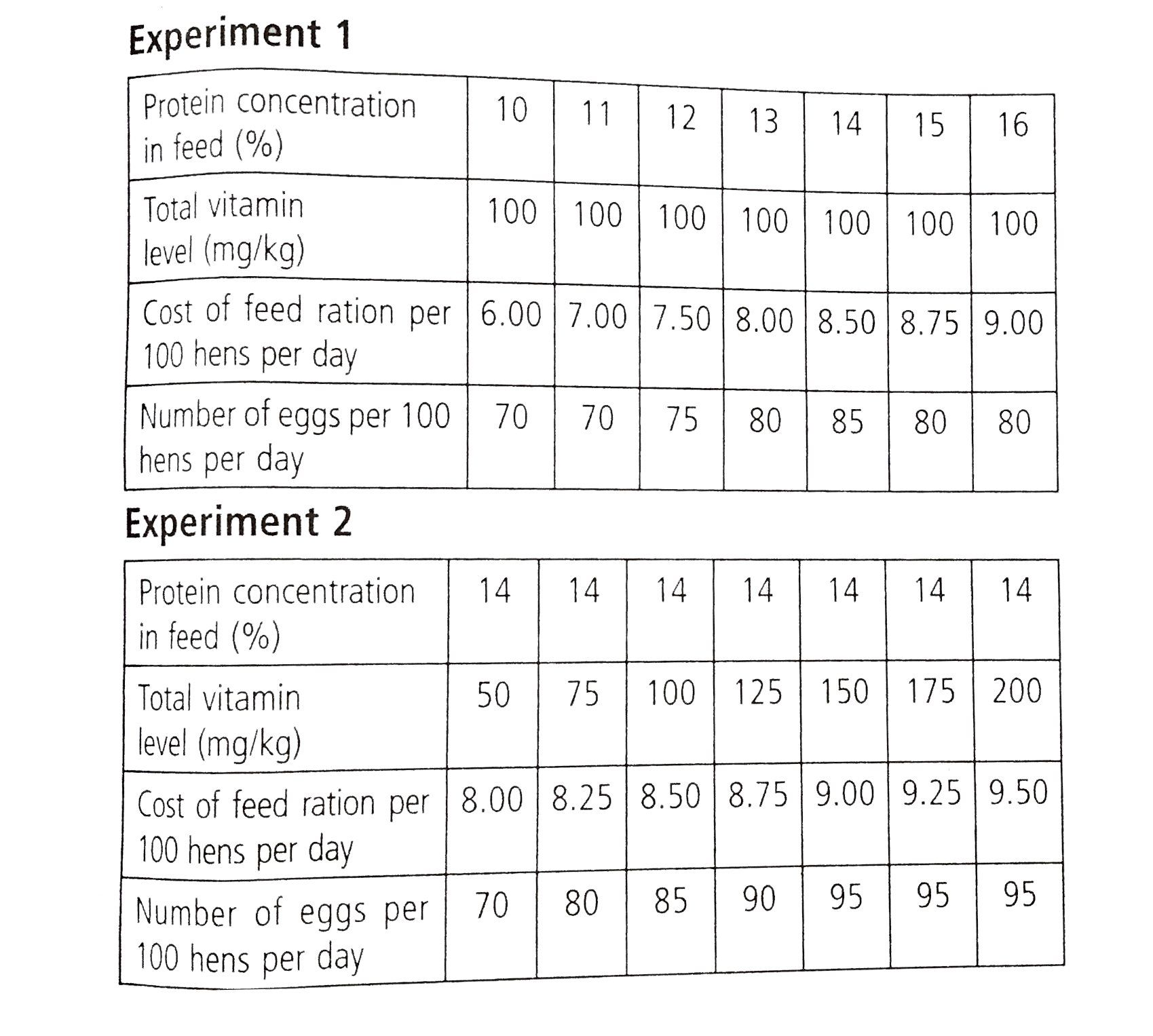
What are the independent variable in each of the two experiments?AExperiment 1Experiment 2Maximum daily egg productionMaximum daily egg productionBExperiment 1Experiment 2Protein concentration in the feedTotal vitamin level in the feedCExperiment 1Experiment 2Total vitamin level the in the feedProtein concentration in feedDExperiment 1Experiment 2Cost of feed ration per egg producedCost of feed ration per egg producedRead the given passage and answer the questions that follows: Rhodinus, a blood-sucking bug, shows five instars before it metamorphoses into an adult. It ahs a very long head with the brain located at tip and an organ called Corpora Cardiaca (C C) behind it. The hormone that ensures the continuum of the juvenile stages is called a juvenile hormone. Behind the head is a pro - thoracic gland, which gets triggered by the Pro - Thoracico - Tropic Hormone (PTTH) to release ecdysone required for molting into an adult.
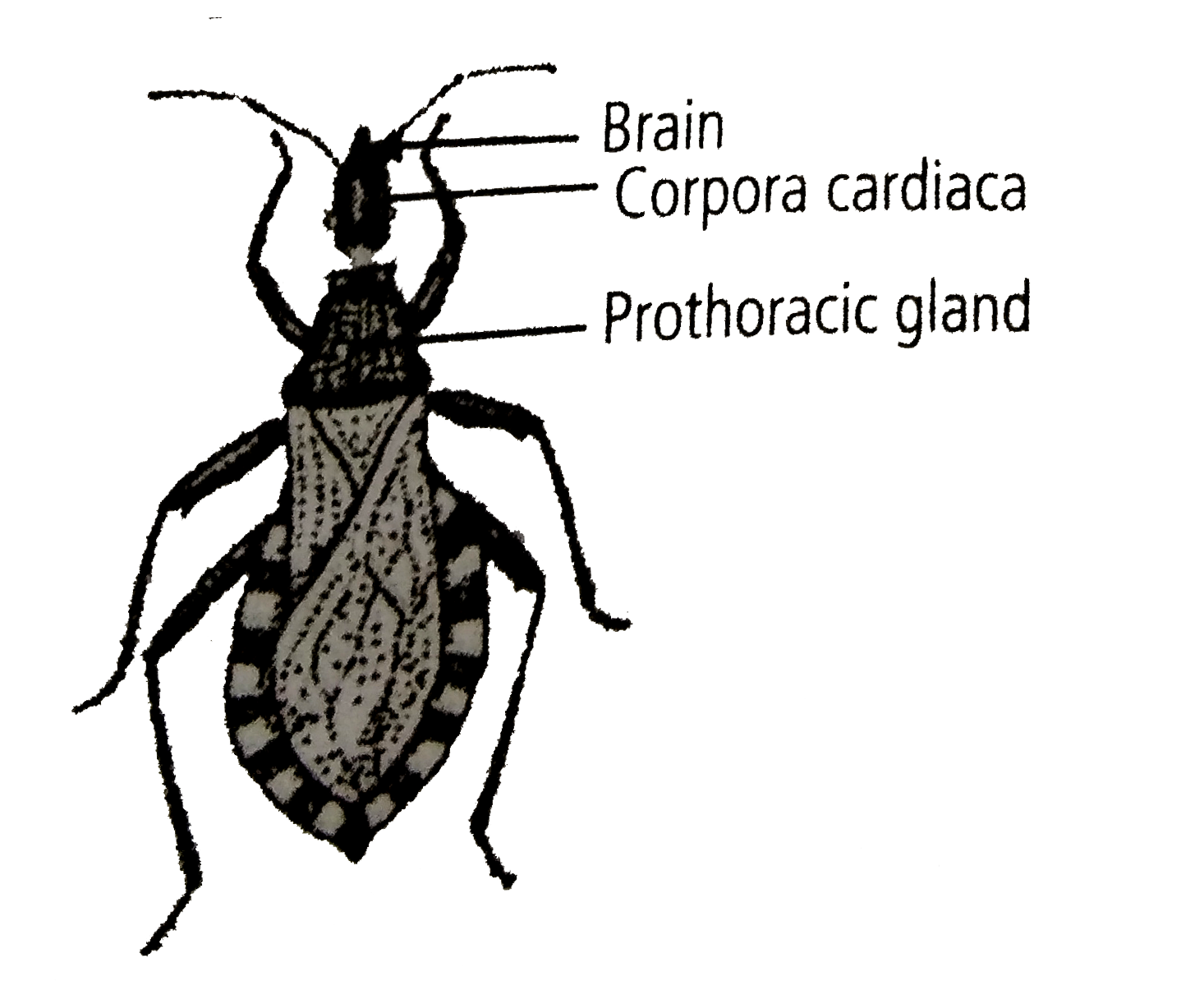
The following observations were made when the juveniles of this insect were subjected to various conditions :
1. Starved juveniles (any instar) when decapitated → remained juveniles and did not molt into adults.
2. Well-fed juveniles (any instar) when decapitated → molted into adults.
3. Starved juveniles (any instar) when partially decapitated to remove the brain cells → remained juveniles and did not molt into adults.
4. Well - fed juveniles (any instar) when partially deitated to remove the brain cells → did not molt into adults.
Which of the following conclusions can be drawn from this data ?
(i) Ecdysone hormone is produced irrespective of the level of feeding.
(ii) C C is the site of production of juvenile hormone.
(iii) PTTH is produced irrespective of the level of feeding.
(iv) Increase in juvenile hormone is an important trigger for production of PTTH.
(v) Absence of C C alone is a trigger for molting into adult form.
(vi) Well-fed larvae in absence of juvenile hotmone can molt into adults.A(i), (iii) (iv) and (v)B(ii), (iv) and (v)C(ii) and (vi)D(i) and (iv)Most chickens reach maturity and begin laying eggs at around 20 weeks of age. From this point forward, however, as the chicken ages,its eges its egg production decreases. A farmer was given a flock of 100 chickens (all of which were the same age) and asked to meaure daily egg output for the entire flock at random intervals starting at maturity until the chickens were 70 weeks old. The data are recorded in the scatteplot below and the line of best fit has been drawn.
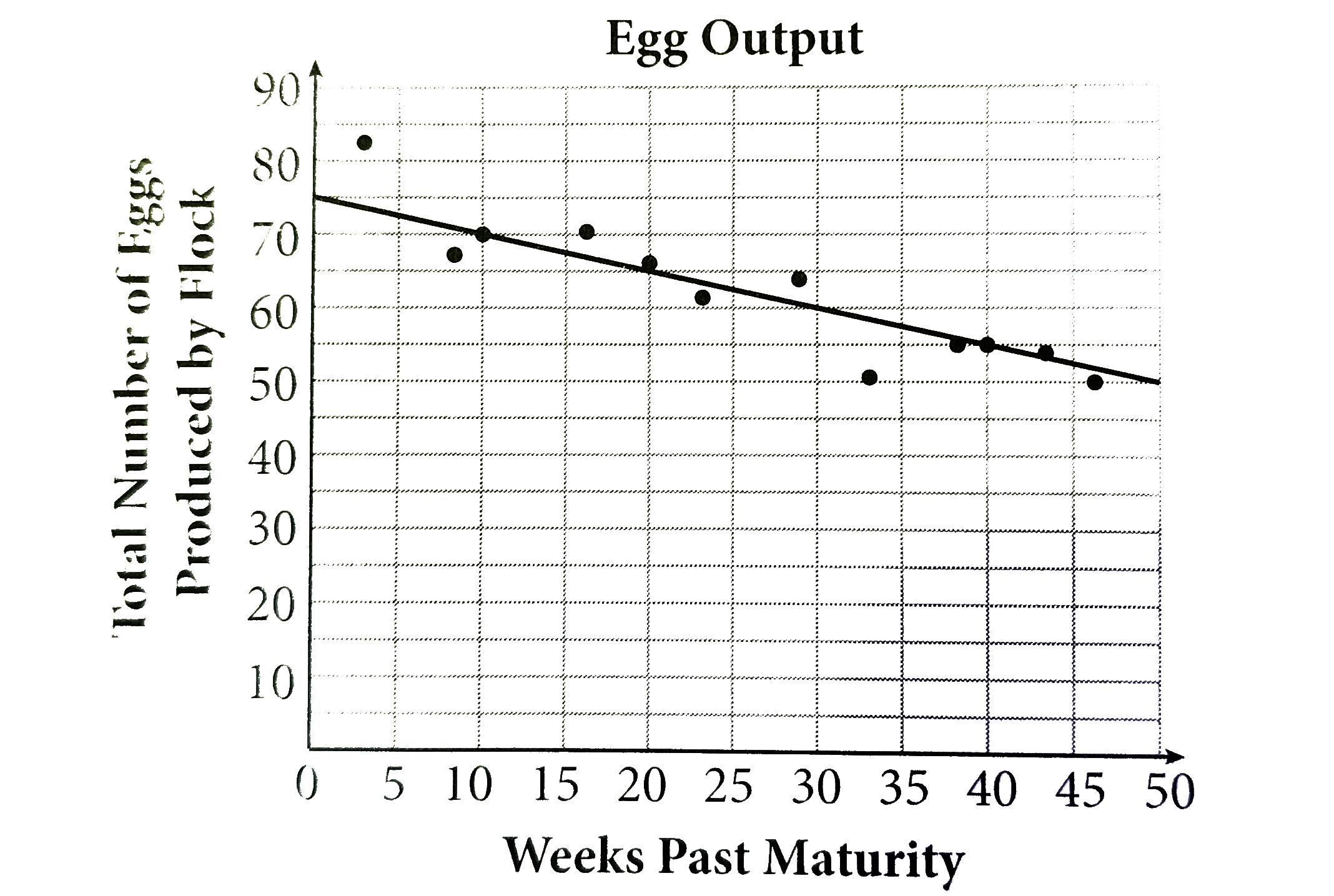
Based on the line of bast fit, what is the predicted number of eggs that will be produced by the flock when it is 33 weeks past maturity ?A33B50C58D64
The Betatron was the first important machine for producing high energy electrons. The action of the betatron depends on the same fundamental principle as that of the transformer in which an alternating current applied to a primary coil induces an altermating current usually with higher or lower voltage in the secondary coil. In the betatron secondary coil is replaced by a doughnut shaped vacuum chamber.Electron produced in the doughnut from a hot filament, are given a preliminary acceleration by the application of an electric field having potential difference of 20kV to 70kV, when an alternating magnetic field is applied parallel to the axis of the tube, two effects are produced (1) an electromotive force is produced in the electron orbit by the changing magnetic flux that gives an additional energy to the electrons (2) a radial force is produced by the action of magnetic field whose direction is perpendicular to the electron velocity. Which keeps the electron moving in a circular path. Conditions are arranged such that the increasing magnetic field keeps the electron in a circular orbit of constant radius. The mathematical relation between the betatron parameters to ensure the above condition is called BETATRON condition.
If the orbit radius of the circular path traced by the electron is R, magnetic field is B, speed of the electron is v, mass of the electron is m, charge on the electron is e and ϕ is the flux within the orbit of radius R. Then answer the following questions based on the above comprehension.
What is the value of d(m|→v|)dt ?
View SolutionRead the following paragraph and answer the questions given below ,
Stable equilibrium is of various types . Mechanical equilibrium is achieved when all particles are at rest and total potential energy of the system is minimum . At any stage where particles are at rest but the system is not at stable equilibrium as it can reduce its potential energy by reverting to another position, is called metastable equilibrium . Thermal equilibrium is result from the absence of temperature gradients in the system. Chemical equilibrium is obtained when no further reaction occurs between reacting substances, i.e forward and reverse rates of reaction are equal. When steam with solid iron at high temperature Fe3O4(s) and hydrogen gas are produced . But the reaction never goes to completion. This is because as the products are formed the reaction proceeds in reverse direction and when rate of reverse reaction is equal to rate of forward reaction , the concentration of reactants and products become constant and equilibrium is reached.
When two reactants (A) and (B) are mixed to give products (C) and (D) the concentration quotient (Q) at initial stage of the reaction
View SolutionWhen it comes to energy, everyone loves efficiency. Cutting energy waste is one of those goals that both sides of the political divide can agree on, Line even it they sometimes diverge on how best to get 5 there. Energy efficiency allows us to get more out of our given resources, which is good for the economy and (mostly) good for the environment as well. In an increasingly hot and crowded world, the only sustainable way to live is to get more out of less. to Every environmentalist would agree. But change the conversation to food, and suddenly efficiency doesn't look so good. Conventional industrial agriculture has become incredibly efficient on a simple land to kind basis. Is Thanks to fertilizers, mechanization and irrigation, each American farmer feeds over 155 people worldwide. Conventional farming gets more and more crop per square foot of cultivated land—over 170 bushels of corn per acre in Iowa, for 20 example—which can mean less territory needs to be converted from wilderness to farmland. And since a third of the planet is already used for agriculture—destroying forests and oilier wild habitats along the way--anything that help us produce more food on less land would seem to he good for the environment.Of course,that’s not how most environmentalists regard their a rugul a[a leaf ygreen].They have embraced organic food as better for the planet—and healthier and tastier,too—than the stuff produced by agricultural corporations.Environmentalists disdain the enormous amounts of energy needed and waste created by conventional farming,while organic practices—for go in gartificial fertilizers and chemical pesticides—are considered far more sustainable. Sales of organic food ros e7.7% in 2010,upto $26.7 billion—and people are making those purchases for their consciences as much as their taste buds. Yet a new meta-analysis in Nature does the math and comes to a hard conclusion:organic farming yields 25% fewer crops on a verage than conventional agriculture.More land is therefore needed to produce fewer crops—and that means organic farming may not be as good for the planet as we think.
In the Nature analysis, scientists from McGill University in Montreal and the University of Minnesota performed an analysis of 66 studies comparing conventional and organic methods across so 34 different crop species, from fruits to grains to legumes. They found that organic farming delivered a lower yield for every crop type, though the disparity varied widely. For rain-watered legume crops like beans or perennial crops like fruit trees, organic is trailed conventional agriculture by just 5%. Yet for major cereal crops like corn or wheat, as well as most vegetables—all of which provide the bulk of the world's calories—conventional agriculture outperformed organics by more than 25%. 60 The main difference is nitrogen, the chemical key to plant growth. Conventional agriculture makes use of 171 million metric tons of synthetic fertilizer each year, and all that nitrogen enables much faster plant growth than the slower release of nitrogen from the 6S compost or cover crops used in organic farming. When we talk about a Green Revolution, we really mean a nitrogen revolution—along with a lot of water. Rut not all the nitrogen used in conventional /0 fertilizer ends up in crops—much of it ends up running off the soil and into the oceans, creating vast polluted dead zones. We're already putting more nitrogen into the soil than the planet can stand over the long term. And conventional agriculture also is depends heavily on chemical pesticides, which can have unintended side effects.
What that means is that while conventional agriculture is more efficient—sometimes much more efficient—than organic farming, there are trade-offs so with each. So an ideal global agriculture system, in the views of the study's authors, may borrow the best from both systems, as Jonathan Foley of the University of Minnesota explained: The bottom line? Today's organic farming 85 practices are probably best deployed in fruit and vegetable farms, where growing nutrition (not just bulk calories) is the primary goal. But for delivering sheer calories, especially in our staple crops of wheat, rice, maize, soybeans and so on, 90 conventional farms have the advantage right now.
Looking forward, I think we will need to deploy different kinds of practices (especially new, mixed approaches that take the best of organic 95 and conventional farming systems) where they are best suited—geographically, economically, socially, etc.
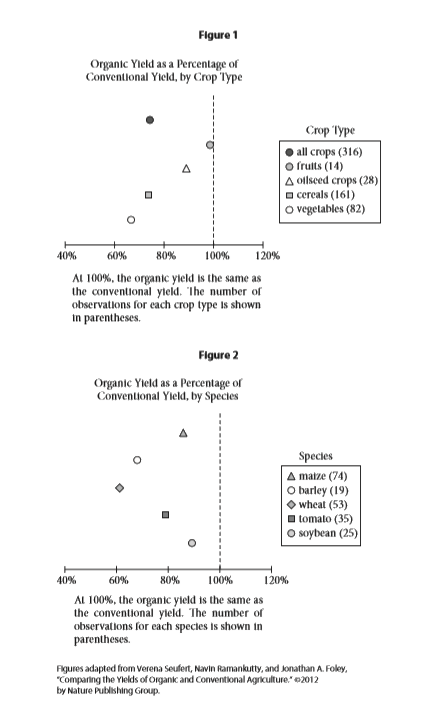
According to the passage,as ignificant attribute of conventional agriculture is its ability to
View SolutionWhen it comes to energy, everyone loves efficiency. Cutting energy waste is one of those goals that both sides of the political divide can agree on, Line even it they sometimes diverge on how best to get 5 there. Energy efficiency allows us to get more out of our given resources, which is good for the economy and (mostly) good for the environment as well. In an increasingly hot and crowded world, the only sustainable way to live is to get more out of less. to Every environmentalist would agree. But change the conversation to food, and suddenly efficiency doesn't look so good. Conventional industrial agriculture has become incredibly efficient on a simple land to kind basis. Is Thanks to fertilizers, mechanization and irrigation, each American farmer feeds over 155 people worldwide. Conventional farming gets more and more crop per square foot of cultivated land—over 170 bushels of corn per acre in Iowa, for 20 example—which can mean less territory needs to be converted from wilderness to farmland. And since a third of the planet is already used for agriculture—destroying forests and oilier wild habitats along the way--anything that help us produce more food on less land would seem to he good for the environment.Of course,that’s not how most environmentalists regard their a rugul a[a leaf ygreen].They have embraced organic food as better for the planet—and healthier and tastier,too—than the stuff produced by agricultural corporations.Environmentalists disdain the enormous amounts of energy needed and waste created by conventional farming,while organic practices—for go in gartificial fertilizers and chemical pesticides—are considered far more sustainable. Sales of organic food ros e7.7% in 2010,upto $26.7 billion—and people are making those purchases for their consciences as much as their taste buds. Yet a new meta-analysis in Nature does the math and comes to a hard conclusion:organic farming yields 25% fewer crops on a verage than conventional agriculture.More land is therefore needed to produce fewer crops—and that means organic farming may not be as good for the planet as we think.
In the Nature analysis, scientists from McGill University in Montreal and the University of Minnesota performed an analysis of 66 studies comparing conventional and organic methods across so 34 different crop species, from fruits to grains to legumes. They found that organic farming delivered a lower yield for every crop type, though the disparity varied widely. For rain-watered legume crops like beans or perennial crops like fruit trees, organic is trailed conventional agriculture by just 5%. Yet for major cereal crops like corn or wheat, as well as most vegetables—all of which provide the bulk of the world's calories—conventional agriculture outperformed organics by more than 25%. 60 The main difference is nitrogen, the chemical key to plant growth. Conventional agriculture makes use of 171 million metric tons of synthetic fertilizer each year, and all that nitrogen enables much faster plant growth than the slower release of nitrogen from the 6S compost or cover crops used in organic farming. When we talk about a Green Revolution, we really mean a nitrogen revolution—along with a lot of water. Rut not all the nitrogen used in conventional /0 fertilizer ends up in crops—much of it ends up running off the soil and into the oceans, creating vast polluted dead zones. We're already putting more nitrogen into the soil than the planet can stand over the long term. And conventional agriculture also is depends heavily on chemical pesticides, which can have unintended side effects.
What that means is that while conventional agriculture is more efficient—sometimes much more efficient—than organic farming, there are trade-offs so with each. So an ideal global agriculture system, in the views of the study's authors, may borrow the best from both systems, as Jonathan Foley of the University of Minnesota explained: The bottom line? Today's organic farming 85 practices are probably best deployed in fruit and vegetable farms, where growing nutrition (not just bulk calories) is the primary goal. But for delivering sheer calories, especially in our staple crops of wheat, rice, maize, soybeans and so on, 90 conventional farms have the advantage right now.
Looking forward, I think we will need to deploy different kinds of practices (especially new, mixed approaches that take the best of organic 95 and conventional farming systems) where they are best suited—geographically, economically, socially, etc.
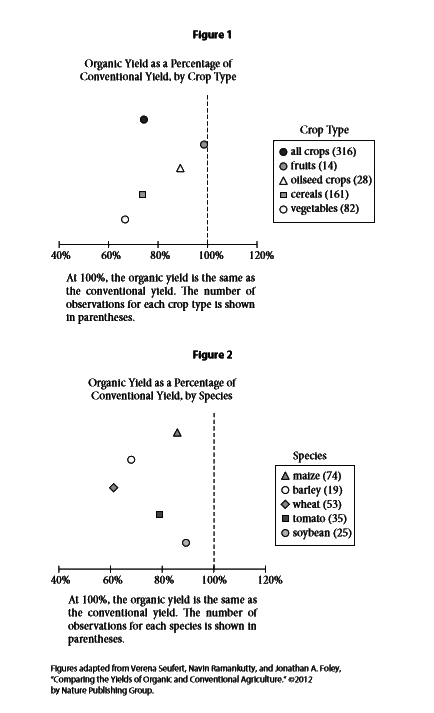
Which of the following claims is supported by figure2?
View SolutionWhen it comes to energy, everyone loves efficiency. Cutting energy waste is one of those goals that both sides of the political divide can agree on, Line even it they sometimes diverge on how best to get 5 there. Energy efficiency allows us to get more out of our given resources, which is good for the economy and (mostly) good for the environment as well. In an increasingly hot and crowded world, the only sustainable way to live is to get more out of less. to Every environmentalist would agree. But change the conversation to food, and suddenly efficiency doesn't look so good. Conventional industrial agriculture has become incredibly efficient on a simple land to kind basis. Is Thanks to fertilizers, mechanization and irrigation, each American farmer feeds over 155 people worldwide. Conventional farming gets more and more crop per square foot of cultivated land—over 170 bushels of corn per acre in Iowa, for 20 example—which can mean less territory needs to be converted from wilderness to farmland. And since a third of the planet is already used for agriculture—destroying forests and oilier wild habitats along the way--anything that help us produce more food on less land would seem to he good for the environment.Of course,that’s not how most environmentalists regard their a rugul a[a leaf ygreen].They have embraced organic food as better for the planet—and healthier and tastier,too—than the stuff produced by agricultural corporations.Environmentalists disdain the enormous amounts of energy needed and waste created by conventional farming,while organic practices—for go in gartificial fertilizers and chemical pesticides—are considered far more sustainable. Sales of organic food ros e7.7% in 2010,upto $26.7 billion—and people are making those purchases for their consciences as much as their taste buds. Yet a new meta-analysis in Nature does the math and comes to a hard conclusion:organic farming yields 25% fewer crops on a verage than conventional agriculture.More land is therefore needed to produce fewer crops—and that means organic farming may not be as good for the planet as we think.
In the Nature analysis, scientists from McGill University in Montreal and the University of Minnesota performed an analysis of 66 studies comparing conventional and organic methods across so 34 different crop species, from fruits to grains to legumes. They found that organic farming delivered a lower yield for every crop type, though the disparity varied widely. For rain-watered legume crops like beans or perennial crops like fruit trees, organic is trailed conventional agriculture by just 5%. Yet for major cereal crops like corn or wheat, as well as most vegetables—all of which provide the bulk of the world's calories—conventional agriculture outperformed organics by more than 25%. 60 The main difference is nitrogen, the chemical key to plant growth. Conventional agriculture makes use of 171 million metric tons of synthetic fertilizer each year, and all that nitrogen enables much faster plant growth than the slower release of nitrogen from the 6S compost or cover crops used in organic farming. When we talk about a Green Revolution, we really mean a nitrogen revolution—along with a lot of water. Rut not all the nitrogen used in conventional /0 fertilizer ends up in crops—much of it ends up running off the soil and into the oceans, creating vast polluted dead zones. We're already putting more nitrogen into the soil than the planet can stand over the long term. And conventional agriculture also is depends heavily on chemical pesticides, which can have unintended side effects.
What that means is that while conventional agriculture is more efficient—sometimes much more efficient—than organic farming, there are trade-offs so with each. So an ideal global agriculture system, in the views of the study's authors, may borrow the best from both systems, as Jonathan Foley of the University of Minnesota explained: The bottom line? Today's organic farming 85 practices are probably best deployed in fruit and vegetable farms, where growing nutrition (not just bulk calories) is the primary goal. But for delivering sheer calories, especially in our staple crops of wheat, rice, maize, soybeans and so on, 90 conventional farms have the advantage right now.
Looking forward, I think we will need to deploy different kinds of practices (especially new, mixed approaches that take the best of organic 95 and conventional farming systems) where they are best suited—geographically, economically, socially, etc.
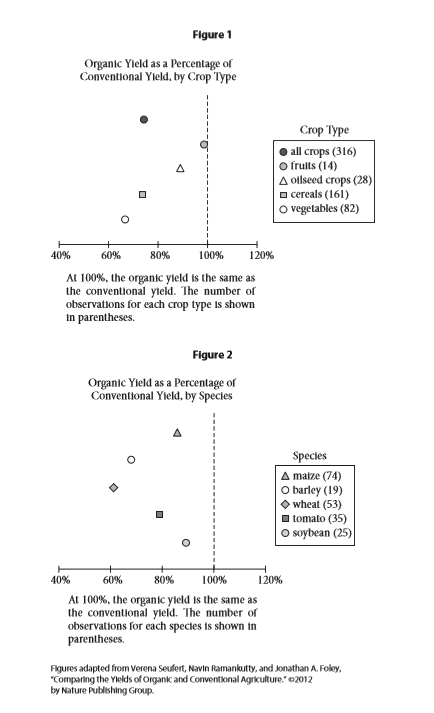
In line88,“sheer”most nearly means
View Solution
